How to Cite | Publication History | PlumX Article Matrix
Andrey Mikhailovich Saykin1, and Maksim Alexeevich Malkin2
1Director of Centre, Doctor of science, Federal State Unitary Enterprise Central Scientific Research Automobile and Automotive Institute "NAMI" (FSUE «NAMI»), Avtomotornaya Street, 2, Moscow, Russia, 125438. 2Head of department, Doctor of philosophy, Federal State Unitary Enterprise Central Scientific Research Automobile and Automotive Institute "NAMI" (FSUE «NAMI»), Avtomotornaya Street, 2, Moscow, Russia, 125438.
ABSTRACT: The article delivers the research results on content of particulates in passenger compartments in the course of driving in urban settings and results of assessment of air cleaning with serial and specially designed cabin air filters. It has been established, that particulates air pollution in passenger compartments in operating conditions is high and dangerous. There is no ecological standards on efficiency of air cleaning in passenger compartments. Thus, the vast majority of cabin air filters are ineffective in dealing with particulates that are less than 1-2 microns, which are the most dangerous for humans. It has been experimentally proven that efficient cabin air cleaning for limiting the content of the particulates that are less than 1-2 microns is technically feasible by means of particular air cleaning ecosystems, which allows justifying development of new ecological standards for “environmentally friendly vehicles”.
KEYWORDS: Motor vehicles; eco vehicles; passenger compartment; air pollution; particulates; tire wear; cabin air filter; ecological standards
Download this article as:| Copy the following to cite this article: Saykin A. M, Malkin M. A. Research on Content of Particulates in Passenger Compartments of Motor Vehicles in Operating Conditions. Biosci Biotechnol Res Asia 2015;12(2) |
Introduction
In the course of motor vehicles (MV) operation, emissions of particulates, emissions of tires, brake shoes and road surface wear products, as well as background air pollution cause high concentration of particulate matter and gaseous toxic components.
Air pollution in MV passenger compartments in real operating conditions, especially in heavy traffic, traffic jams, tunnels etc., often exceeds hygienic standards (Azarov et al., 2014; Saykin, 2013; Sager and Schmidt, 2009; Sager, 2012). In spite of the fact that practically all modern cars, first of all passenger cars, are equipped with incoming air filtration systems, efficiency of these systems remains insufficient, therefore a driver and passengers are affected by pollutants present in the air (Azarov et al., 2014; Saykin, 2013; Sager and Schmidt, 2009; Sager, 2012; Zhang, 2006; Sager and Schmidt, 2010; Heschel and Ahnert, 1998; Bittermann, 1996; Klijn et al., 1997; Ilgen, 2008; Kievit, 1997; Qi et al., 2008; Stepanov, 2008; Althausen and Lastochkin, 2002; Ananyev et al., 2003, Terenchenko and Karpukhin, 2014, Bahmutov S.V. and Karpukhin K.E. 2012).
Actual data on MV passenger compartments air pollution by priority harmful substances are understudied. It is also necessary to consider the absence of ecological regulations as to the efficiency of air cleaning by cabin air filters (Azarov et al., 2014; Saykin, 2013; Automotive Handbook, 2004). This article delivers research results on content of particulates in MV passenger compartments air in the operating conditions.
Methods
The research was conducted on three Moscow auto-roads: Dmitrovskoye High-road, Bolshaya Akademicheskaya Street and the 4th Novomikhalkovsky Driveway. The research was also conducted on emission of tire wear products in the course of wear process modelling by means of grinding of tire tread outer surface with abrasive paper and in the course of drive wheels tire slipping on a road surface and on a metal sheet (on a jacked vehicle) (Azarov et al., 2014).
On-road research was conducted in conditions of maximum and minimum traffic load in suitable weather conditions, advantageous for minimum air pollution by other sources of particulate emissions. In the course of conducting the research, weight and quantitative content of particulates from 0.3 to 25 microns was estimated with hand particulate counter Lighthouse Handheld 3016 (USA).
Measurements of the particulates contents in a passenger compartment were conducted on the passenger car “Volkswagen Passat Variant” with a cabin air filter Mahle LA45 (Germany) installed in the climate control system of the car (Azarov et al., 2014). The particulate counter was placed on a rear seat, in the center of the passenger compartments with sampling equipment directed to the front. The research was conducted with closed windows and air conditioning system operating in a forced ventilation mode. The air temperature in the passenger compartment did no exceed 18°С.
Research Results
Comparative data on the particulates contents in the passenger compartment and in the ambient air in quantitative and weight units are shown on Pictures 1 and 2 respectively. The corresponding data are also shown in tabular form in Tables 1 and 2.
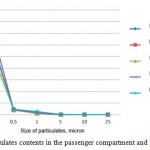 |
Figure 1 :Particulates contents in the passenger compartment and in the ambient air |
Table 1: Particulates contents in the passenger compartment of a passenger car and in the ambient air (data for the Picture 1)
| Object | Amount of particulates in absolute values, divided according to size ranges | |||||
| 0.3 micron | 0.5 micron | 1.0 micron | 5.0 micron | 10 micron | 25 micron | |
| Passenger compartment, evening (a traffic jam) | 40303463.14 | 3449377.68 | 924926.42 | 13401.92 | 5279.54 | 0.00 |
| Passenger compartment, morning (light traffic) | 47522098.74 | 2771000.60 | 878046.20 | 12377.79 | 7592.65 | 0.00 |
| Passenger compartment, evening (light traffic) | 40978068.51 | 2980429.41 | 878628.89 | 12285.22 | 6848.90 | 0.00 |
| Passenger compartment, morning (heavy traffic) | 56192926.39 | 3166613.15 | 1173347.44 | 10770.97 | 3619.75 | 0.00 |
| Ambient air, evening (heavy traffic) | 48908782.09 | 3250759.17 | 1948486.71 | 127485.94 | 15979.89 | 22.07 |
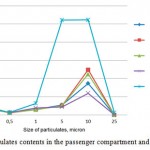 |
Figure 2: Particulates contents in the passenger compartment and in the ambient air |
Table 2: Particulates contents in the passenger compartment and in the ambient air (data for Picture 2)
| Object | Particulates concentration in mg/cubic m, divided according to size ranges | |||||
| 0.3 micron | 0.5 micron | 1.0 micron | 5.0 micron | 10 micron | 25 micron | |
| Passenger compartment, evening (a traffic jam) | 0.0007 | 0.0003 | 0.0006 | 0.0011 | 0.0035 | 0.0000 |
| Passenger compartment (light traffic) | 0.0008 | 0.0002 | 0.0006 | 0.0010 | 0.0050 | 0.0000 |
|
Passenger compartment, evening (light traffic) |
0.0007 | 0.0002 | 0.0006 | 0.0010 | 0.0045 | 0.0000 |
| Passenger compartment, morning (heavy traffic) | 0.0010 | 0.0003 | 0.0008 | 0.0009 | 0.0024 | 0.0000 |
| Ambient air, evening (heavy traffic) | 0.0009 | 0.0003 | 0.0013 | 0.0104 | 0.0105 |
0.0002 |
The Pictures 1 and 2 and Tables 1 and 2 show that:
- The cabin air filters efficiently clean air only of particulates that are larger than 2 – 5 micron, while the most dangerous for humans is the particulate matter that is less than 2 micron.
- Contents of particulates up to 1 micron in cabin air with air conditioning system operating in a intake air supply mode is no different from that on the roadway.
Pictures 3 and 4 below show, in quantitative and weight units respectively, the comparative data on particulates air pollution obtained in the course of studying products of wear formation and emission into the air, in the course of modeling processes of wear by grinding tires, in comparison with data on air pollution in the drive wheels zone and in the passenger compartment in operating conditions. The corresponding data in tabular form are provided in Tables 3 and 4.
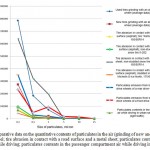 |
Figure 3: Comparative data on the quantitative contents of particulates in the air (grinding of new and used tires with an abrasive wheel; tire abrasion in contact with a road surface and a metal sheet; particulates contents in the drive wheels zone while driving; particulates contents in the passenger compartment air while driving in urban settings) |
Table 3: Comparative data on the quantitative contents of particulates in the air (data for the Picture 3)
| Type of testing | Amount of particulates in absolute values, divided according to size ranges | |||||
| 0.3 micron | 0.5 micron | 1.0 micron | 5.0 micron | 10 micron | 25 micron | |
| Used tires grinding (average data) | 785104 | 184373 | 71048 | 2847 | 4252 | 88 |
| New tires grinding (average data) | 274458 | 25539 | 21953 | 4345 | 7744 | 283 |
| Tire abrasion in contact with a road surface (asphalt); all-season tire “Kama-208”, 185/60R14 (Russia) | 73857 | 7912 | 3428 | 254 | 124 | 0.182 |
| Tire abrasion in contact with a road surface (asphalt); non-studded snow tire К-202 “Metelitsa”, 185/65R14 (Russia) | 94523 | 14869 | 7065 | 485 | 452 | 9 |
| Tire abrasion in contact with a metal sheet; non-studded snow tire К-202 “Metelitsa”, 185/65R14 (Russia) | 641727 | 320442 | 196970 | 201 | 119 | 1 |
| Tire abrasion in contact with a road surface (asphalt); studded snow tire Michelin X-Ice North, 175/65R14 | 43122 | 8027 | 8308 | 1761 | 2248 | 55 |
| Particulates emission from beneath drive wheels of a rear drive vehicle | 351501 | 30040 | 17251 | 1930 | 556 | 0 |
| Particulates emission from beneath drive wheels of a front drive vehicle | 232400 | 49682 | 94247 | 17907 | 14830 | 62 |
| Particulates contents in the air of the MV passenger compartment while driving in urban settings (light traffic) | 67283.80 | 3923.30 | 1243.18 | 17.53 | 10.75 | 0.00 |
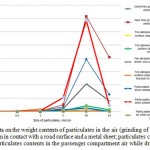 |
Figure 4: Comparative data on the weight contents of particulates in the air (grinding of new and used tires with an abrasive wheel; tire abrasion in contact with a road surface and a metal sheet; particulates contents in the drive wheels zone while driving; particulates contents in the passenger compartment air while driving in urban settings) |
Table 4: Comparative data on the weight contents of particulates in the air (data for the Picture 4)
| Type of testing |
Particulates concentration in mg/cubic m, divided according to size ranges |
|||||
| 0.3 micron | 0.5 micron | 1.0 micron | 5.0 micron | 10 micron | 25 micron | |
| Used tires grinding (average data) | 0.010 | 0.011 | 0.033 | 0.164 | 1.965 | 0.636 |
| New tires grinding (average data) | 0.003 | 0,001 | 0.010 | 0.251 | 3.578 | 2.043 |
| Tire abrasion in contact with a road surface (asphalt); all-season tire “Kama-208”, 185/60R14 (Russia) | 0.001 | 0.0004 | 0.002 | 0.015 | 0.057 | 0.001 |
| Tire abrasion in contact with a road surface (asphalt); non-studded snow tire К-202 “Metelitsa”, 185/65R14 (Russia) | 0.001 | 0.001 | 0.003 | 0.028 | 0.209 | 0.062 |
| Tire abrasion in contact with a metal sheet; non-studded snow tire К-202 “Metelitsa”, 185/65R14 (Russia) | 0.008 | 0.018 | 0.090 | 0.012 | 0.055 | 0.004 |
| Tire abrasion in contact with a road surface (asphalt); studded snow tire Michelin X-Ice North, 175/65R14 | 0.001 | 0.0005 | 0.004 | 0.102 | 1.039 | 0.398 |
| Particulates emission from beneath drive wheels of a rear drive vehicle | 0.002 | 0.001 | 0.004 | 0.056 | 0.128 | 0 |
| Particulates emission from beneath drive wheels of a front drive vehicle | 0.001 | 0.001 | 0.022 | 0.517 | 3.426 | 0.225 |
| Particulates contents in the air of the MV passenger compartment while driving in urban settings (light traffic) | 0.001 | 0.0002 | 0.001 | 0.001 | 0.005 | 0 |
Pictures 3 and 4 above show, that conducted research is methodically justified and provided basis for explaining air pollution with particulates (tire and road surface wear products) over roadways and in passenger compartments. The research has shown that air pollution in passenger compartments is high and dangerous for drivers and passengers, and, as follows from the released data (Sager and Schmidt, 2009; Sager, 2012; Zhang, 2006; Sager and Schmidt, 2010; Heschel and Ahnert, 1998; Bittermann, 1996; Klijn et al., 1997; Ilgen, 2008; Kievit, 1997; Qi et al., 2008; Bauhof and Wensing, 1999; Grabbs et al., 1999; Broun and Сheng, 2006; Bulycheva, 2011, Yudaeva, 2011; Klimenko and Ryabikov, 2010), particulates less than 1 micron, that are the most dangerous for humans, are not blocked by the majority of cabin air filters.
These data have been confirmed by results of tests for efficiency of air cleaning of particulates by means of the serial cabin air filter of “Škoda Octavia” (Picture 5) and the model of a cabin air cleaning ecosystem designed by FSUE “NAMI” (Picture 6) (Azarov et al., 2014). Results of assessment are given in the Picture 7 and in the Table 5.
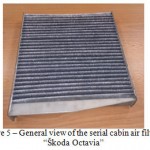 |
Figure 5: General view of the serial cabin air filter of “Škoda Octavia” |
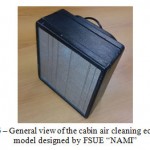 |
Figure 6: General view of the cabin air cleaning ecosystem model designed by FSUE “NAMI” |
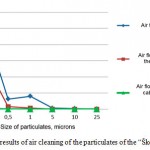 |
Figure 7: Efficiency assessment results of air cleaning of the particulates of the “Škoda Octavia” with cabin air filters |
Table 5: Efficiency assessment results of air cleaning of the particulates of the “Škoda Octavia” with cabin air filters (data for the Picture 7)
| Object | Amount of particulates in absolute values, divided according to size ranges | |||||
| 0.3 micron | 0.5 micron | 1.0 micron | 5.0 micron | 10 micron | 25 micron | |
| Air flow at the filter input | 248405 | 31429 | 40603 | 3603 | 2127 | 8 |
| Air flow at the filter output of “Škoda Octavia” | 139168 | 8262 | 3727 | 208 | 21 | 0 |
| Air flow at the filter output of FSUE “NAMI” | 2162 | 107 | 30 | 2 | 1 | 0 |
The data in the Picture 7 and Table 5 show that:
the serial cabin air filter of “Škoda Octavia” has low efficiency of air cleaning for particulates less than micron;
the air cleaning ecosystem model designed by FSUE “NAMI” in the passenger compartment of a passenger car of “Škoda Octavia” has two-times higher efficiency of air cleaning of particulates, compared to the serial cabin air filter of that vehicle.
Summary
Generally, following the results of the conducted research the following conclusion can be made. Particulates air pollution of the passenger compartments in operating conditions is high and dangerous. There is no ecological standards on air cleaning in passenger compartments efficiency. Thus, the vast majority of cabin air filters are ineffective in dealing with particulates that are less than 1-2 microns, which are the most dangerous for humans. It has been experimentally proven that efficient cabin air cleaning for limiting the content of the particulates that are less than 1-2 microns is technically feasible by means of particular air cleaning ecosystems, which allows justifying development of new ecological standards for “environmentally friendly vehicles”. In the framework of further research on this issue, the first-priority targets are development of a regulatory basis in order to limit the content of the particulates in air cabins and development of cleaning means for cleaning the air inside.
Acknowledgments
The paper was prepared under the agreement # 14.625.21.0006 with the Ministry of Education and Science of the Russian Federation (unique project identifier RFMEFI62514X0006) to create an experimental model of an environmentally friendly electric vehicle.
References
- Azarov, V., Saikin, A., Kutenev, V., and Malkin, M. (2014). Tires and the Road Surface as a Source of Air Pollution Vehicles. Works of NAMI, 256, 72 – 84.
- Saykin, А.М. (2013). New Concept of Environmentally Friendly Transport. Saarbrücken: LAP LAMBERT Academic Publishing.
- Sager, U. and Schmidt, F. (2009). Adsorption of Nitrogen Oxides, Water Vapour and Ozone onto Activated Carbon. Adsorption Science & Technology, 27 (2), 135–145. http://dx.doi.org/10.1260/026361709789625243.
- Sager, U. (2012). Automotive Air Quality: Adsorption Performance of a Cabin Air Filter During a Life Cycle. Filtration & Separation, 49 (4), 38 – 41. http://dx.doi.org/10.1016/S0015-1882(12)70199-4.
- Zhang, P., Sager, U., Schmidt, F., Wanko, H. and Ulrich, J. (2006). Untersuchung des Adsorptionsverhaltens von Dünnschichtfiltern am Beispiel der Kfz-Innenraumfilter. Chemie Ingenieur Technik, 78 (12), 1837–1844. http://dx.doi.org/10.1002/cite.200600071.
- Sager, U. and Schmidt, F. (2010). Binary Adsorption of n-Butane or Toluene and Water Vapor. Chemical Engineering & Technology, 33 (7), 1203–1207. http://dx.doi.org/10.1002/ceat.201000086.
- Heschel, W. and Ahnert, F.F. (1998). Chem. Tech., 50 (6), 293–301.
- Bittermann, H. (1996). Proceedings of the Filtration 96, International Conference & Exposition. Baltimore, MD, USA, December 1996.
- Klijn, J., Waque J. and Neveling V. (1997). Proceedings of the 2nd International Conference on Nonwovens in Filtration. Stuttgart, D, March 1997.
- Ilgen, B. (2008). Proceedings of the 9th Symposium Textile Filter. Chemnitz, D: Sächsisches Textilforschungsinstitut Chemnitz (STFI), March 2008.
- Kievit, O. (1997). Proceedings of the 10th AFS Annual Conference. Minneapolis, MN, USA, April–May 1997.
- Qi, C., Stanley, N., Pui, D. Y. H. and Kuehn T. H. (2008). Laboratory and On-Road Evaluations of Cabin Air Filters Using Number and Surface Area Concentration Monitors. Environmental Science & Technology, 42 (11), 4128–4132. http://dx.doi.org/10.1021/es703216c.
- Stepanov, I.S. (2008). Bodies and Passenger Compartments. In A.L. Karunin (Ed.), Automobile Design (Vol. 3). Мoscow: Goryachaya Liniya – Telekom.
- Althausen, A.L., Lastochkin, S.A. (2002). Air Conditioning and Climate Control Systems. Moscow: Automobiles Charts.
- Ananyev, V.A. et. al. (2003). Ventilation and Air Conditioning Systems. Theory and Practice. Moscow: Euroclimate.
- Automotive Handbook (2nd ed.). (2004). Moscow: ZAO “RZI “Za Rulyom”.
- Bauhof, H. and Wensing, M. (1999). Standard Test Methods for the Determination of VOCs and SVOCs in Automobile Interiors, in Organic Indoor Air Pollutants. Wiley–VCH, Weinheim, pp. 105–115.
- Grabbs, J. S., Corsi, R. L. and Torres, V. M. (1999). A Screening Assessment of Volatile Organic Compounds in the interior of new automobiles. Proceedings of First NSF International Conference on Indoor Air Health. Denver: NSF International, 3 – 5 May, 1999.
- Broun, S. K. and Сheng, M. (2006). Volatile organic compounds (VOC’s) in new car interiors. CSIRO Building, Construction and Engineering. Highett, Australia. URL: http://www.mindfully.org/Plastic/New-Car-Interior-VOCs30nov00.htm.
- Bulycheva, Z. Y. (2011). Development of test methods to evaluate volatile organic compounds and aldehydes on the details of interior of vehicles and the details of interior of vehicles and the prospects for their regulation of international and Russian technical legislation // Development of national R&D works base: VIII International Automobile Scientific Forum (20th Oct., 2010): coll. of science art. Works of NAMI, 246, 142 – 149.
- Yudaeva O.S. (2011). Improvement of Working Conditions of Train Attendants Using Modern Polymeric Materials in Railroad Passenger Cars Interior (PhD Tech. Thesis). Moscow State University of Railway Engineering (MIIT), Moscow, Russia.
- Klimenko, A. and Ryabikov, O. (2010). Polymer Bionanocomposites for Automotive Industry // VII International Automobile Scientific Forum (21 – 22th Oct., 2010): coll. of science art. Works of NAMI, 243, 100 – 111.
- Terenchenko A.S. and Karpukhin K.E. (2014) Energy efficiency as a way of improving the environmental safety of vehicles. Transactions of NIZHNI NOVGOROD STATE TECHNICAL UNIVERSITY n.a. R.Y. Alekseev (2014), 4 (106), 299-305.
- Bahmutov S.V., Karpukhin K.E., (2012), “Pure” cars: the directions of realization and reached results. Zhurnal avtomobil’nyh inzhenerov, 6 (77), (51-54).

This work is licensed under a Creative Commons Attribution 4.0 International License.





